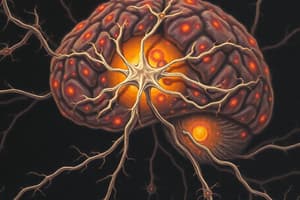Podcast
Questions and Answers
What cells are responsible for producing myelin in the central nervous system?
What cells are responsible for producing myelin in the central nervous system?
- Astrocytes
- Microglia
- Schwann cells
- Oligodendrocytes (correct)
What are the two categories of cells unique to the nervous system?
What are the two categories of cells unique to the nervous system?
Neurons and Glia
Resting potential is the steady state membrane potential of a ____________ neuron.
Resting potential is the steady state membrane potential of a ____________ neuron.
resting
Neurons communicate with other cells at synapses through electrical synapses only.
Neurons communicate with other cells at synapses through electrical synapses only.
Match the neurotransmitter receptor type with its characteristics:
Match the neurotransmitter receptor type with its characteristics:
What is the role of interneurons?
What is the role of interneurons?
Flashcards are hidden until you start studying
Study Notes
Nervous System Overview
- The nervous system consists of two categories of cells: neurons (nerve cells) and glia (glial cells)
- Neurons generate and transmit electrical signals, while glia provide support and maintain the extracellular environment
- A common neural stem cell gives rise to all cells in the nervous system
Structure of a Typical Neuron
- Neurons have a basic structure consisting of dendrites, cell body, axon, and terminals
- Dendrites receive signals, the cell body integrates the signals, the axon transmits the signal, and the terminals release neurotransmitters
Types of Glial Cells
- Macroglia: oligodendrocytes, astrocytes, and Schwann cells
- Oligodendrocytes produce myelin and insulate axons in the CNS
- Astrocytes contribute to the blood-brain barrier and provide nutrients to neurons
- Schwann cells insulate axons in the PNS
- Microglia provide immune defenses in the CNS
Neuron Communication
- Neurons communicate with each other and with other cells through electrical and chemical signals
- Electrical signals: action potentials, ion channels, and ion transporters
- Chemical signals: neurotransmitters, synapses, and receptors
Action Potentials
- Action potentials are rapid, large, and transient changes in membrane potential
- The sodium-potassium pump establishes concentration gradients and generates the resting potential
- Voltage-gated Na+ channels open and close to generate the action potential
- The refractory period is the time during which the neuron cannot generate another action potential
Synapses
- Chemical synapses: release of neurotransmitters from the presynaptic cell, binding to receptors on the postsynaptic cell
- Electrical synapses: direct electrical connection between neurons through gap junctions
- The neuromuscular junction is a chemical synapse between motor neurons and skeletal muscle cells
Neurotransmitters and Receptors
- Neurotransmitters bind to specific receptors to elicit a response
- Ionotropic receptors: ligand-gated ion channels, fast and excitatory
- Metabotropic receptors: G-protein coupled receptors, slower and longer-lived
- Examples of neurotransmitters: ACh, glutamate, GABA, dopamine
Neural Networks
- Neurons are organized into neural networks for information processing
- Afferent neurons carry sensory information, efferent neurons carry commands, and interneurons integrate information
- The central nervous system (CNS) consists of the brain and spinal cord, while the peripheral nervous system (PNS) consists of neurons and support cells outside the CNS
Studying That Suits You
Use AI to generate personalized quizzes and flashcards to suit your learning preferences.





